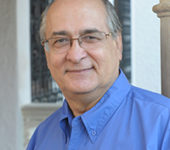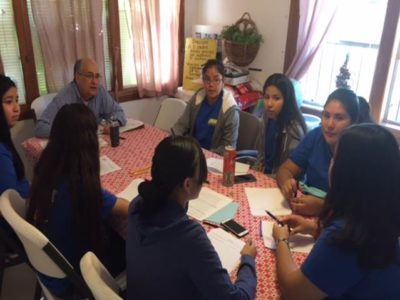By Aurelio M. Montemayor, M.Ed., Bronce Yahir Márquez, Andrea Guadalupe Guzmán and Litzy Castro • IDRA Newsletter • March 2017 •


While one group is editing video clips, another is recording voice-over, and a third is working on an essay on the three projects highlighted in the video. This venture illustrates meaningful community projects conducted by young people that also are being documented for school credit.
The youth attend 10 different schools from six school districts. High-schoolers form the core of the group accompanied by younger siblings. Three ARISE centers located in colonias (unincorporated rural communities) sponsor and mentor the youth’s leadership projects with, in this case, the common theme of environmental justice.
Deeply connected to families, ARISE faces community issues and challenges directly. Their children take on projects to help meet those challenges. Adult mentors and teachers assist with and facilitate the activities.
These student-led projects addressing community issues are rich learning contexts with inherent academic and social lessons, well known to educators who use project based learning. Project based learning is an ideal instructional process, undergirded by knowledge and skills standards, learner-centered, authentically connected to challenging problems or questions, and an opportunity for student voice, choice, reflection and presentation to their families and schools.
But these projects began in the community and are engaging with their schools rather than the traditional school-to-community route.
ARISE is a grassroots organization founded in 1987 that has fostered youth volunteerism in members’ own communities. Since its inception, it has offered a summer multi-week program to provide activities for young children to have fun and learn while being mentored by youths from the same neighborhoods.
If those activities had been connected to academic products, those teenagers could have written essays and stories and created multimedia presentations on how to help young children learn to read with joy or why community service is important… all for class credit.
Now, returning to the Saturday morning activities… In writing sessions that were held concurrently to the video completion, the students identified certain elements that were common across all projects: serving the community, improving the environment, taking action to reduce or solve environmental challenges, and committing time to the activities in spite of very busy school schedules. Following are samples of the youth projects.

The ARISE Muñiz project, 2C K (Clean, Change and Keep it that way) is in three colonias. The project aims to model for families cleaning up the environment, changing the world and keeping it that way with recycling and re-use. Because their neighborhoods have very limited public services, these students are collecting trash, tires and recyclable products and are encouraging all families to follow their example.
As they meet regularly to plan and carry out their activities, they will have a connection to their classes. They document and write about their actions and communicate with families to create a consciousness about protecting the environment. “We want to feel proud of our neighborhood,” one student wrote. “We are the living history of the future generations.”
The ARISE South Tower Environmental Justice youth team is in its second year of battling to change an open sewage treatment plant that has long plagued its neighborhoods. As the youth write, “We want to confront environmental racism, make justice happen, eliminate bad odors and have equality in communities.” Because of the efforts last year in speaking to the city and county elected officials, a million-dollar grant was obtained to seek a solution to the problem.
The youth team received the U.S. Environmental Protection Agency President’s Environmental Youth Award and the Texas House Award presented by the Texas Low-Income Housing Information Service. As they continue to face the problem, they inform their communities and persist in advocating for clean air, “Just because our neighborhoods are not where the rich people live doesn’t mean we have to put up with the bad odor.”
The Las Milpas Youth Project is Galaxy Park. A vacant park owned by the city, after several meetings with public officials, was adopted by a group of almost two dozen youths to “create a place where kids can be safe playing and where mothers can feel good about letting their children play.” They wrote, “We have cleaned the lot so that we can create a park.” Brainstorming in the initial stage of creating an essay to inform on the project, they wrote: “The problem: Empty and unsafe space for kids and an abandoned, barren landscape. The solution includes: Youth staying active; A place where the neighborhood can socialize; and A place where children can play.”
These secondary school and college-age students have visited the Santana Wildlife Conservatory and met with city officials to get the proper permits to create the park and to have the city prepare the lot with heavy machinery. The team is studying plants that are native to the area and would be appropriate for a park and a habitation for the Monarch Butterfly. They will disseminate information to introduce Galaxy Park and create ownership among the families in the neighborhoods.
Learning Objectives and Project Based Learning
The video weaves three projects. The students had initial instruction in creating a video, scripting and story-boarding. Each team videotaped their project and then collectively created an opening and closing. The video they are producing spans a significant array of knowledge and skills in video technology, English and social studies. Each project will result in products that individual students will present to teachers for credit (see box).
The project based learning coordinator of Pharr-San Juan-Alamo ISD is working with the project mentors and is facilitating the school connections for academic credit. They are working out the challenges of connecting multi-age/multi-school teams to specific teachers and classes.
When the school-based project exhibits are presented later this spring, the ARISE students will be there. The ARISE community groups will be in the audience at their May meetings in Spanish. All the projects will be bilingual, linguistically appropriate for school and community.
In addition to the environmental justice projects, these youths will participate in an informational campaign on the Zika threat and will conduct educational activities on college preparation and access.
ARISE youth leadership projects, community initiated and supported, are now informed by project based learning. Students will be presenting their work to their schools and teachers for academic credit. Beyond the yearly community service letters ARISE already provides to student volunteers, a new and significant step has been taken to connect with schools and teachers. Educators now validate the substantive skills and knowledge involved in the work students are doing in the community.
Resources
Fletcher, A. (2016). “Youth-Led Activism,” webpage (Olympia, Wash.: The Freechild Project).
Montemayor, A.M., & N. Chavkin. (2016). Liderazgo Familiar Intergeneracional: Intergenerational Family Leadership as a New Paradigm of Family Engagement, VUE Voices in Urban Education.
Montemayor, A.M. (November-December 2016). “College Students Describe What a School’s College-Going Culture Really Means – Full Interviews,” IDRA Newsletter (San Antonio, Texas: Intercultural Development Research Association).
Montemayor, A.M. (May 2016). “Youths in Action – Intergenerational Leadership,” IDRA Newsletter (San Antonio, Texas: Intercultural Development Research Association).
Montemayor, A.M. (April 2016). “Students Become Leaders in their Community to Support Peers on the Path Toward College,” IDRA Newsletter (San Antonio, Texas: Intercultural Development Research Association).
Unitarian Universalist Association. (no date). “Service and Social Justice for Youth,” webpage (Boston, Mass.: Unitarian Universalist Association).
Also see…
ARISE Website
ARISE Facebook
#MakeMercyReal
![]()
![]()
See our photo slideshow with highlights from the students’ PBL work
![]()
![]()
Get the “4 Stages of Writing” activity the ARISE students used
and Get an overview of the ARISE Pilar de Jovenes ~ Youth Pillar project outline
___________________________________________________________________________
Sidebar: Community-Based Projects’ Connection to State Learning Standards
A key objective from the Texas standards for video production is in innovative cognition. The student is expected to apply English language arts knowledge and skills by:
- Demonstrating use of content, technical concepts and vocabulary;
- Using correct grammar, punctuation and terminology to write and edit documents; and
- Composing and editing copy for a variety of written documents, such as scripts, captions, schedules, reports and manuals.
Other objectives vary by project but some apply to all. For example, in language arts, the students are developing an engaging idea reflecting depth of thought and specific details and relevance.
In social studies, the students are
- Expressing ideas orally based on research and experiences;
- Creating written and visual material, such as journal entries and reports based on their research.
- Using a problem-solving process to identify a problem, gather information, list and consider options, consider advantages and disadvantages, choose and implement a solution, and evaluate the effectiveness of the solution.
Math and science objectives also are incorporated. These learning objectives are taken from the Texas Essential Knowledge and Skills which are central to instruction in public schools. A longer array has been identified and is guiding the mentors across all projects.
—————————————-
Aurelio M. Montemayor, M.Ed., is an IDRA senior education associate and director of the IDRA Education CAFÉ project. Comments and questions may be directed to him via email at aurelio.montemayor@idra.org. Bronce Yahir Marquez is a senior at Southwest High School in Pharr-San Juan-Alamo ISD, Andrea Guadalupe Guzmán is a junior at Donna High School in Donna ISD. Litzy Castro is a sophomore at Johnny G. Economedes High school in Edinburg CISD.


